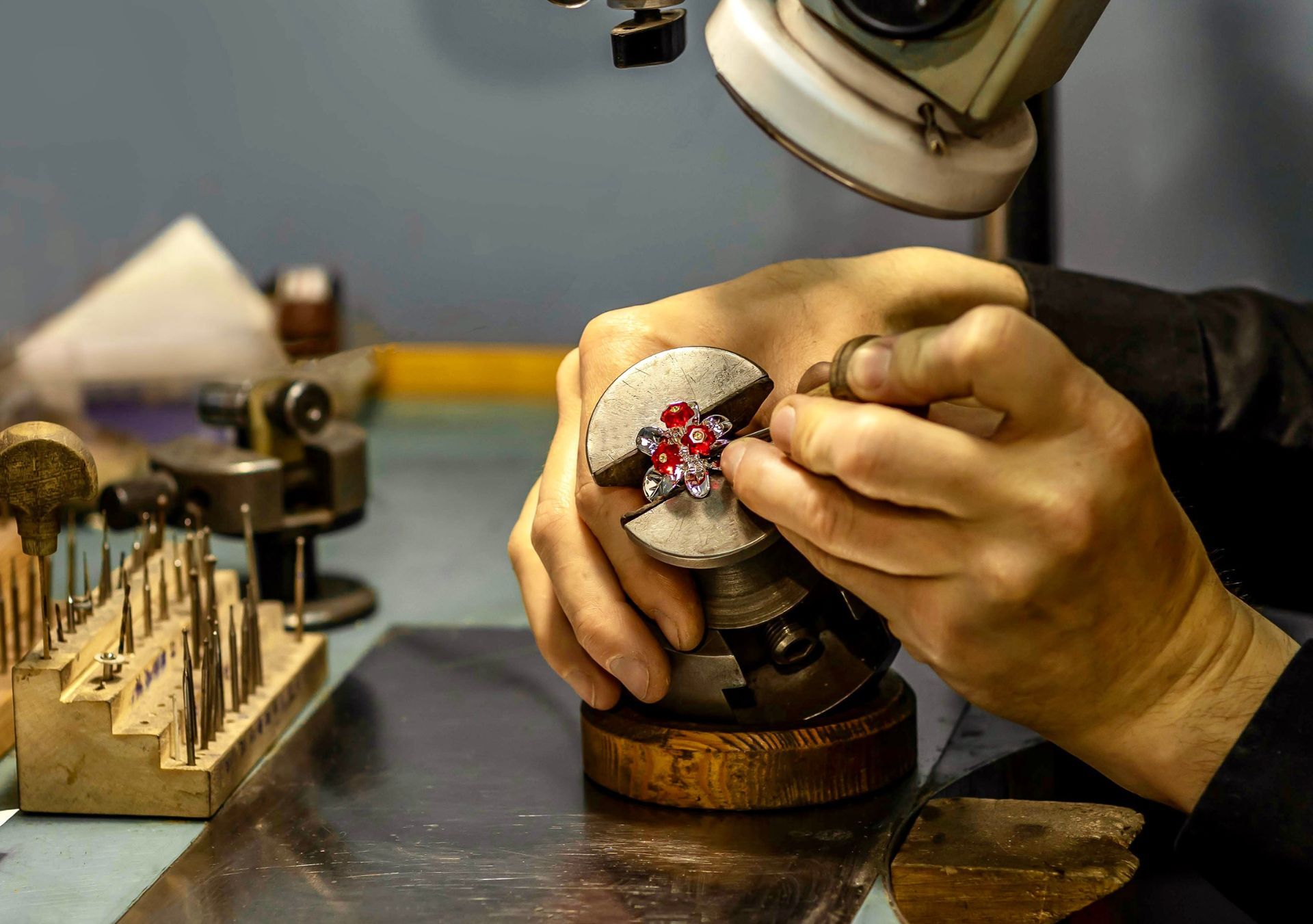
Most Common Business Policies
Index
Contact Us
Jewelry is not just an accessory; it is often a prized possession that represents significant investment and sentiment. For jewelers in Texas, protecting their assets through specialized insurance is crucial. This guide delves into the importance of jeweler insurance, the types available, costs, provider selection, claim processes, and much more.
Understanding the Importance of Jeweler Insurance in Texas
Jeweler insurance is an essential safety net for businesses in the jewelry industry. It provides protection against various risks, including theft, loss, and damage to goods. The significance of these policies cannot be overstated, especially in a thriving market like Texas, where the jewelry industry is dynamic and diverse.
The Role of Jeweler Insurance
The primary role of jeweler insurance is to safeguard against financial losses resulting from unforeseen events. This can include losses from burglaries, natural disasters, or accidental damages. Those who invest in inventory, equipment, and physical stores need to have a solid plan in place to cover any potential financial fallout.
Moreover, jeweler insurance aids in maintaining business continuity. If a catastrophic event occurs, having insurance means that you can recover, restock, and reopen sooner rather than later. For jewelers, this translates to customer trust and long-term viability. In addition to protecting physical assets, many policies also cover liability claims, which can arise from customer injuries or property damage during business operations. This comprehensive coverage ensures that jewelers can focus on their craft without the looming fear of financial ruin from unexpected incidents.
Why Texas Jewelers Need Insurance
In Texas, the risk of theft is notably high in urban areas, making insurance a necessity rather than a luxury for jewelers. The geographical and economic landscape increases vulnerability. A reported increase in crime in major cities exemplifies the urgent need for protective measures among jewelers.
Additionally, Texas jewelers often deal with high-value items, ranging from high-end jewelry to precious stones. Without adequate insurance, the potential for significant financial loss can jeopardize a jeweler's livelihood. With jeweler insurance, these businesses can operate with peace of mind, knowing they have coverage in place. Furthermore, the unique cultural landscape of Texas, with its rich history in craftsmanship and artistry, means that many jewelers also offer custom pieces that hold sentimental value for their clients. This not only elevates the stakes in terms of financial investment but also emphasizes the need for protection against loss or damage to these irreplaceable items. As a result, jewelers are encouraged to work closely with insurance professionals to tailor their policies to fit the specific needs of their business and clientele.

Types of Coverage for Texas Jewelers
Texas jewelers can choose from various types of insurance coverage tailored to their unique needs. Understanding these options can help jewelers make informed decisions about their policies.
Comprehensive Coverage
Comprehensive coverage is one of the most extensive options available. This policy often covers a wide range of risks, including theft, loss, damage during transit, and damage to business premises. For jewelers, this means that most potential threats are accounted for under a single policy.
Such coverage often extends beyond just the physical inventory. It can also include protection for liability claims, protecting the jeweler from lawsuits arising from customer injuries or product defects. Comprehensive coverage is ideal for jewelers who want all-round protection. Additionally, many comprehensive policies offer coverage for business interruption, which can be crucial in maintaining financial stability during unforeseen events like natural disasters or significant theft incidents. This aspect ensures that jewelers can continue to meet their financial obligations even when their operations are temporarily halted.
Specific Risk Coverage
While comprehensive coverage provides broad protection, specific risk coverage focuses on particular hazards pertinent to a jeweler's operations. For instance, jewelers who frequently travel with valuable items may benefit from policies that cover items in transit or provide protection during exhibitions and trade shows.
This type of coverage allows jewelers to customize their insurance according to their specific risks, thereby avoiding unnecessary expenses on broader policies that may not fully suit their operational needs. Moreover, jewelers who specialize in high-value items, such as rare gemstones or antique jewelry, may find it advantageous to seek out specific coverage that addresses the unique valuation and appraisal processes associated with these items. This ensures that they are adequately protected against market fluctuations and potential losses that could arise from theft or damage to these irreplaceable pieces.
The Cost of Jeweler Insurance in Texas
The cost of jeweler insurance can vary significantly based on a multitude of factors. Understanding these factors is essential for jewelers to budget appropriately and find the right policy for their business without overspending.
Factors Influencing Insurance Costs
Several elements come into play when determining the cost of jeweler insurance: the value of the inventory, the size of the business, location, and even the jeweler’s claims history.
- Value of Inventory: Higher inventory values usually translate to higher premiums.
- Business Location: Areas with higher crime rates may attract higher insurance costs.
- Claims History: A history of frequent claims can lead to steeper premiums.
Understanding these factors allows jewelers to assess their insurance needs accurately and shop for policies that match their financial capacities. Additionally, the type of jewelry being insured can also play a role; for instance, insuring high-value items like diamonds or rare gemstones may incur higher premiums due to their increased risk of theft or loss. Jewelers should also consider the specific types of coverage they require, such as protection against natural disasters or liability coverage for customer injuries, as these can further influence the overall cost of their insurance policy.
Ways to Lower Your Insurance Premiums
Reducing insurance premiums is a desire shared by many business owners. Fortunately, there are effective strategies available. Jewelers can consider bundling their policies for discounts, increasing deductibles, or investing in security measures.
- Bundle Policies: Combining multiple insurance policies with one provider often reduces overall costs.
- Increase Deductibles: Higher deductibles can lower monthly premiums, provided the jeweler can afford upfront costs in case of a claim.
- Invest in Security: Installing high-quality security systems or implementing tighter security protocols can make a business less risky to insurers, thus lowering premiums.
In addition to these strategies, jewelers might also explore the option of joining industry associations or groups that offer collective bargaining power for insurance rates. These organizations often have established relationships with insurers and can negotiate better terms for their members. Furthermore, maintaining a good credit score can also positively impact insurance rates, as insurers often consider creditworthiness when determining premiums. By taking proactive steps to enhance their risk profile, jewelers can not only save money but also ensure they are adequately protected against unforeseen events.
How to Choose the Right Insurance Provider
Selecting an insurance provider is a momentous task for jewelers. It involves considering various aspects of the insurance market and discerning the best fit for their unique needs.
Evaluating Insurance Providers
When evaluating potential insurance providers, jewelers should look at the insurer’s reputation, customer service history, financial stability, and specialization in dealing with jewelry businesses.
Reading customer reviews and ratings can provide insight into how responsive and supportive an insurer is, particularly in times of need. Furthermore, it is beneficial to assess whether the provider has a strong claims process in place, which is crucial for jewelers who may encounter losses. A provider with a streamlined claims process can significantly reduce the stress and downtime associated with filing a claim, allowing jewelers to focus on their craft rather than administrative hurdles. Additionally, jewelers should inquire about the insurer's experience with similar businesses, as this can indicate their understanding of the unique risks and challenges faced in the jewelry industry.
Questions to Ask Potential Providers
As jewelers assess different providers, asking the right questions can lead to informed decision-making. Here’s a list of crucial questions to consider:
- What specific coverages do you offer for jewelers?
- How do you handle claims, and what is the process like?
- Are there discounts available for security measures in place?
Each of these questions can unearth valuable information to guide jewelers toward a suitable insurance provider. Additionally, jewelers might want to ask about the insurer's policy on coverage limits and exclusions, as understanding these details can help avoid unpleasant surprises in the event of a claim. It’s also wise to inquire about the insurer's approach to risk assessment; providers who take the time to understand a jeweler's specific operations and vulnerabilities are often better equipped to offer tailored coverage options that truly meet their needs. By engaging in these discussions, jewelers can build a relationship with their potential provider that goes beyond mere transactions, fostering a partnership that prioritizes their business's security and success.
The Process of Filing a Claim
Understanding the process of filing a claim is paramount for jewelers to navigate any future incidents smoothly. Having this knowledge helps ensure that they do not miss critical steps or deadlines. A well-prepared jeweler can mitigate stress during challenging times by being familiar with the claims process, allowing them to focus on their business and customer relationships instead of getting bogged down in paperwork.
Steps to File a Claim
Filing a claim typically involves several key steps. Firstly, jewelers should document the incident thoroughly, including collecting evidence such as photographs or police reports. This documentation will support their claims process. Additionally, it is advisable to keep a detailed log of any communication related to the incident, including dates, times, and the names of individuals spoken to. This log can prove invaluable if there are any disputes or misunderstandings later in the process.
Next, the jeweler must notify the insurance provider promptly, as most policies require claims to be reported within a specific timeframe. The provider will guide the jeweler through the claims process, explaining the necessary documentation and steps to finalize the claim. Jewelers should also review their insurance policy beforehand to understand the coverage limits and any exclusions that may apply, ensuring they are fully informed when discussing their claim with the insurer.
What to Expect After Filing a Claim
Once a claim is filed, jewelers should expect a review process where the insurer evaluates the case and determines coverage based on the policy terms. This process can vary in duration depending on the complexity of the claim. During this time, it’s beneficial for jewelers to gather any additional information or documentation that may be requested by the insurer, as this can help expedite the review process and demonstrate their commitment to resolving the issue.
Communication from the insurer is essential during this period, and the jeweler should remain proactive in following up on the claim’s status. Maintaining open lines of communication can not only help clarify any uncertainties but also establish a rapport with the claims adjuster, which can be advantageous. Ultimately, prompt resolution and support from the insurer during the claims process can significantly impact the jeweler’s recovery experience. Being prepared for potential outcomes, including negotiations or appeals, can further empower jewelers to navigate this challenging time with confidence and clarity.
Common Misconceptions about Jeweler Insurance
Despite its importance, many misconceptions surround jeweler insurance. Clarifying these misconceptions can help jewelers make informed decisions about their coverage needs.
Debunking Insurance Myths
One prevalent myth is that all insurance policies are the same and primarily cover theft alone. In reality, jeweler insurance encompasses various coverage types, including liability and damage. Jewelers must understand the specifics of their coverage rather than make assumptions.
Another myth is that insurance is an unnecessary expense. While it may seem like an added cost, the protection it provides is invaluable, especially for high-value items. Jewelry businesses without insurance are vulnerable to devastating financial losses. For instance, a single incident of theft or damage could wipe out a small business's inventory, leading to insurmountable debt and potential bankruptcy.
The Truth about Jeweler Insurance
The truth about jeweler insurance is that it is essential for risk management for jewelry businesses. With a well-structured policy, jewelers can navigate risks effectively and maintain peace of mind while focusing on their craft. This peace of mind extends beyond just the physical protection of inventory; it also allows jewelers to engage with clients confidently, knowing that their business is safeguarded against unforeseen circumstances.
In addition, insurance policies can often be tailored to fit the unique needs of a jeweler’s business, ensuring comprehensive protection regardless of size or type of inventory. This level of customization is what sets jeweler insurance apart. For example, some policies may include coverage for loss of stones, damage during repairs, or even coverage for items in transit. Jewelers can also opt for business interruption insurance, which provides financial support during periods when they are unable to operate, ensuring that they can recover and continue their business without severe financial strain.

Future of Jeweler Insurance in Texas
The insurance industry is continuously evolving, and jewelers must stay abreast of future trends that could impact their coverage and business operations. Understanding these developments can help jewelers anticipate changes and adapt accordingly.
Predicted Changes in the Insurance Industry
As technology advances, there will likely be innovations in how insurance is marketed and delivered. Digital platforms are becoming more common, providing jewelers with easy access to compare policies, obtain quotes, and file claims online.
Moreover, an increased emphasis on cybersecurity will shape insurance offerings. With jewelers conducting more online transactions, insurers may develop specialized products to address risks related to digital theft and fraud.
In addition to cybersecurity, the rise of artificial intelligence and machine learning is set to transform underwriting processes. Insurers may leverage these technologies to analyze vast amounts of data, allowing for more personalized coverage options tailored to the unique needs of jewelers. This shift could lead to more competitive pricing and improved risk assessments, ultimately benefiting both the insurer and the insured.
Preparing for the Future of Jeweler Insurance
To prepare for future developments, jewelers should actively engage with their insurance providers to stay informed about new products and coverage options. Incorporating technology into their businesses can also deter risks, making them more appealing to insurers.
Furthermore, jewelers should consider investing in comprehensive training for their staff on the importance of security protocols and risk management practices. By fostering a culture of awareness and preparedness, businesses can significantly reduce their vulnerability to theft and fraud. Additionally, collaborating with industry associations can provide valuable insights into best practices and emerging trends, ensuring that jewelers remain at the forefront of the evolving insurance landscape.
Ultimately, staying proactive will ensure that jewelers in Texas can adapt to changes seamlessly while continuing to thrive in a competitive landscape.


